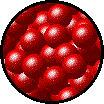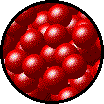
Source: lotemp, Purdue University - Department of Chemistry

Source: hitemp, Purdue University - Department of Chemistry
The thermal energy of a substance is the total of all the kinetic energy of all the atoms and molecules that make up that substance plus all the potential energy stored in bonds between those atoms and molecules. Whether they are transferring from one part of a gas or liquid to another or vibrating in their vertex of a crystalline structure, all atoms within matter are always moving.



![]() Some of this thermal energy is the result of internal reactions, and some comes from the environment. In the following simulation, you increase the thermal energy of two textbooks through friction by rubbing them together:
Some of this thermal energy is the result of internal reactions, and some comes from the environment. In the following simulation, you increase the thermal energy of two textbooks through friction by rubbing them together:
Click the reset button, watch the motion of the individual atoms. What happens as the temperature falls?
Interactive popup. Assistance may be required. The vibrations of the atoms are slowing down. CloseNow use your mouse to rub the yellow book against the green book. What happens?
Interactive popup. Assistance may be required. The atoms begin to vibrate more and the temperature rises. CloseHeat is the transfer of thermal energy from one object to another. Heat can be measured in Joules, but the more traditional unit is the calorie (lower case c). One food Calorie (upper case C) is 1000 heat calories. Joules and calories are related by the following:
Thermal energy will always transfer from an object with more energy to an object with less energy. Heat travels from object to object, cold does not. When you put ice in a drink, cold does not transfer from the ice to the drink, heat travels from the drink into the ice.